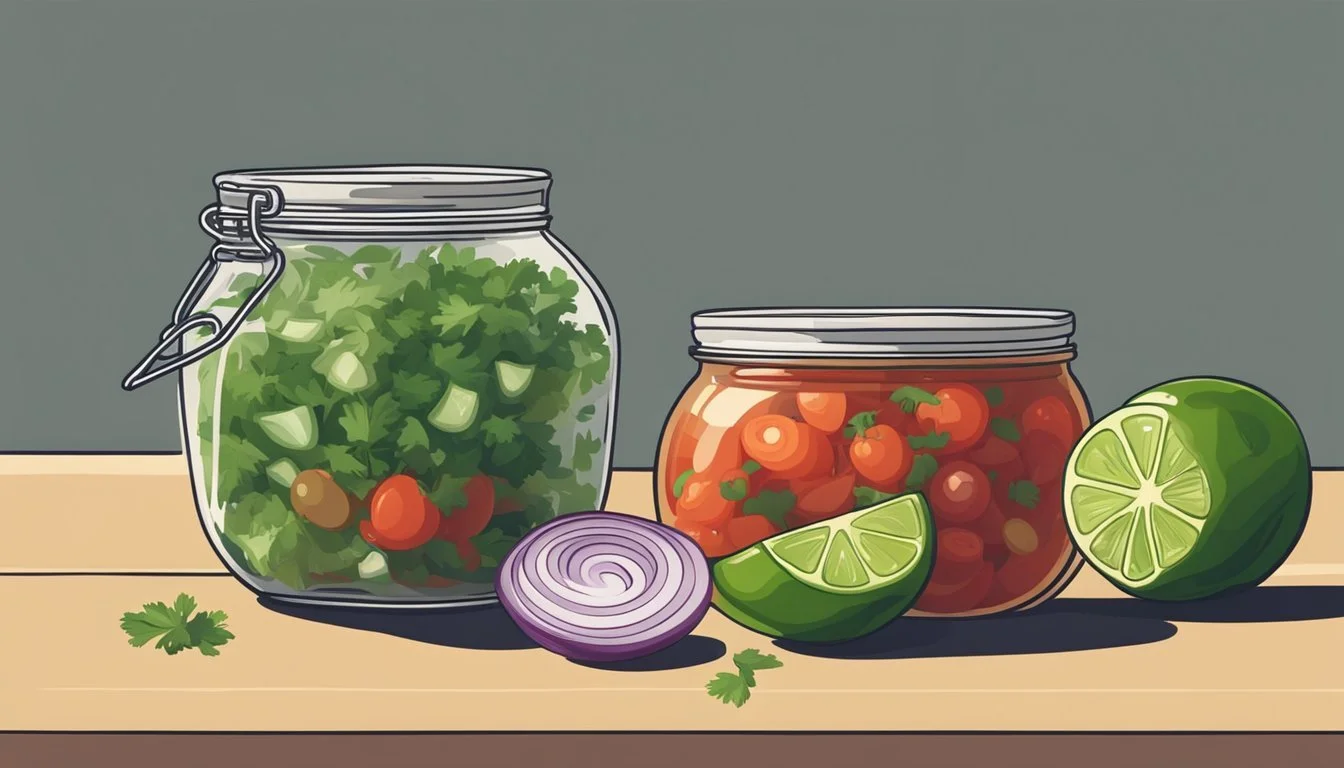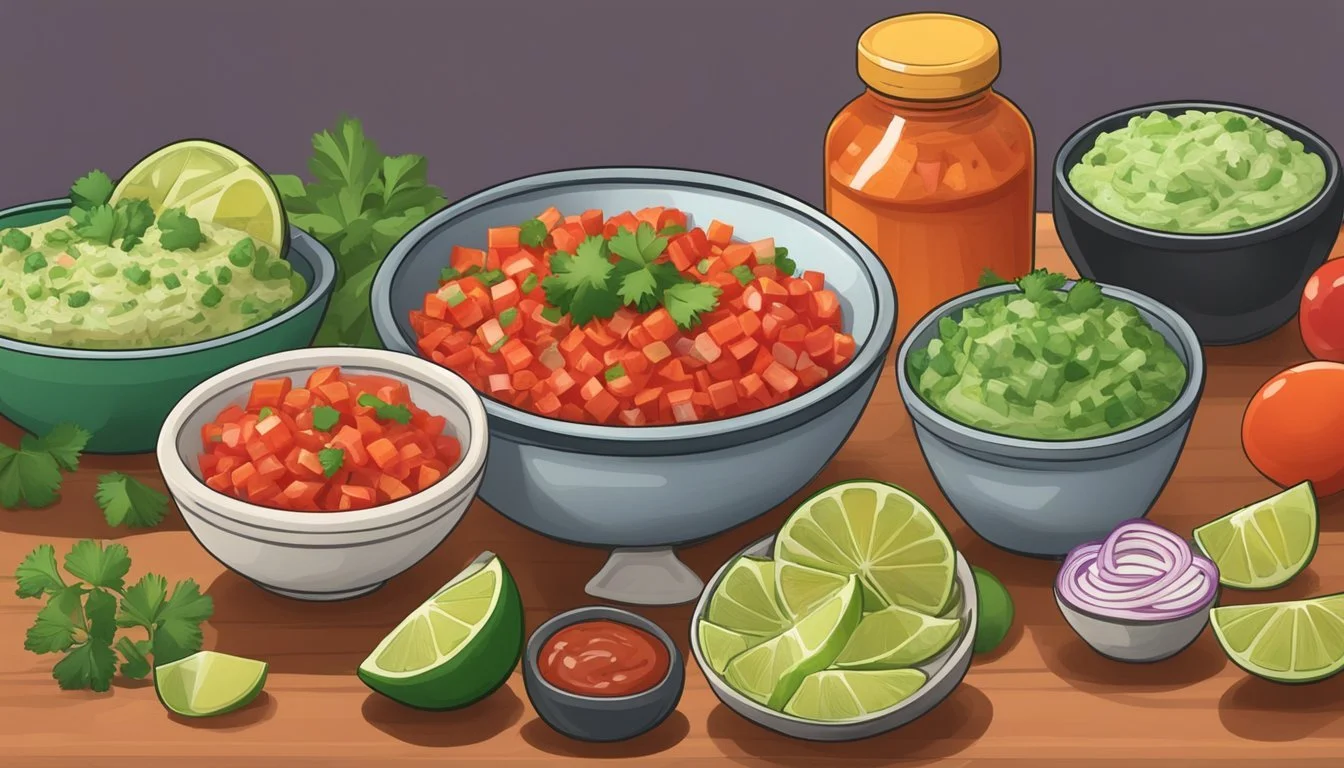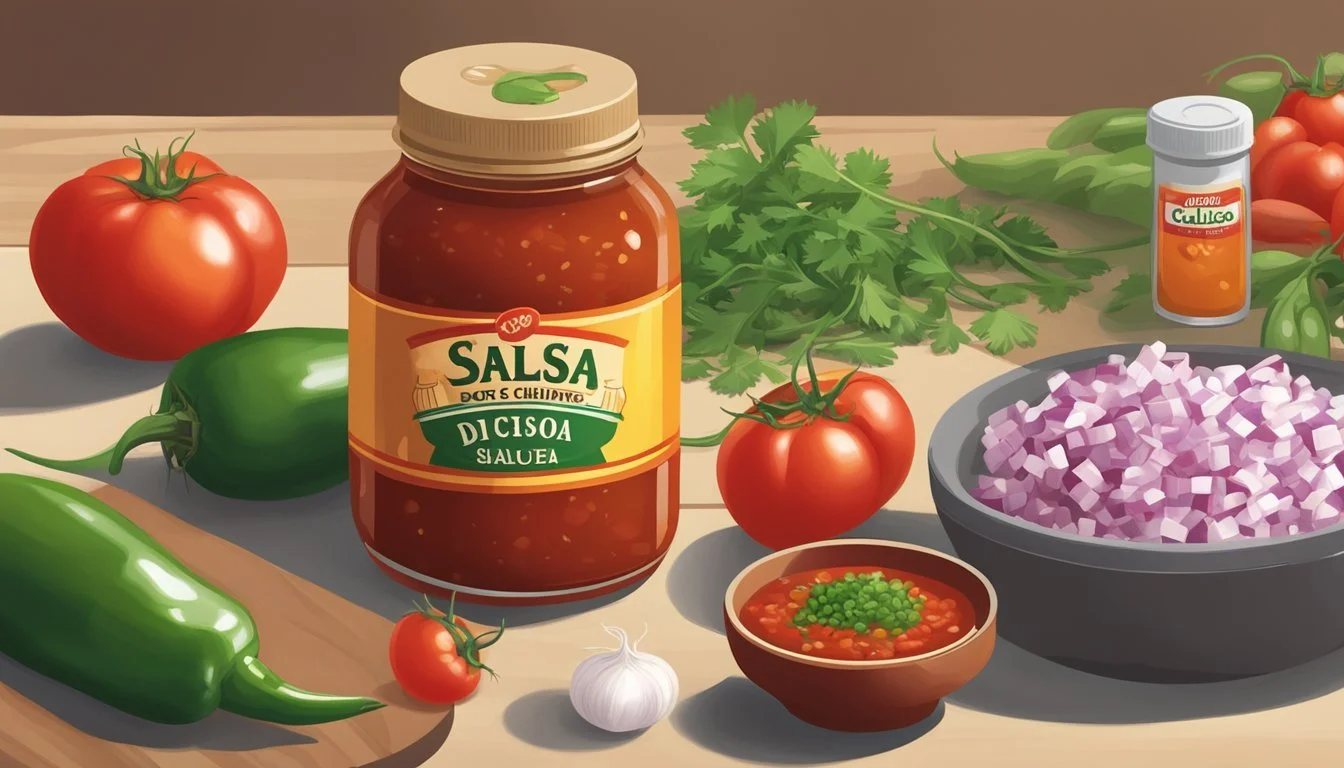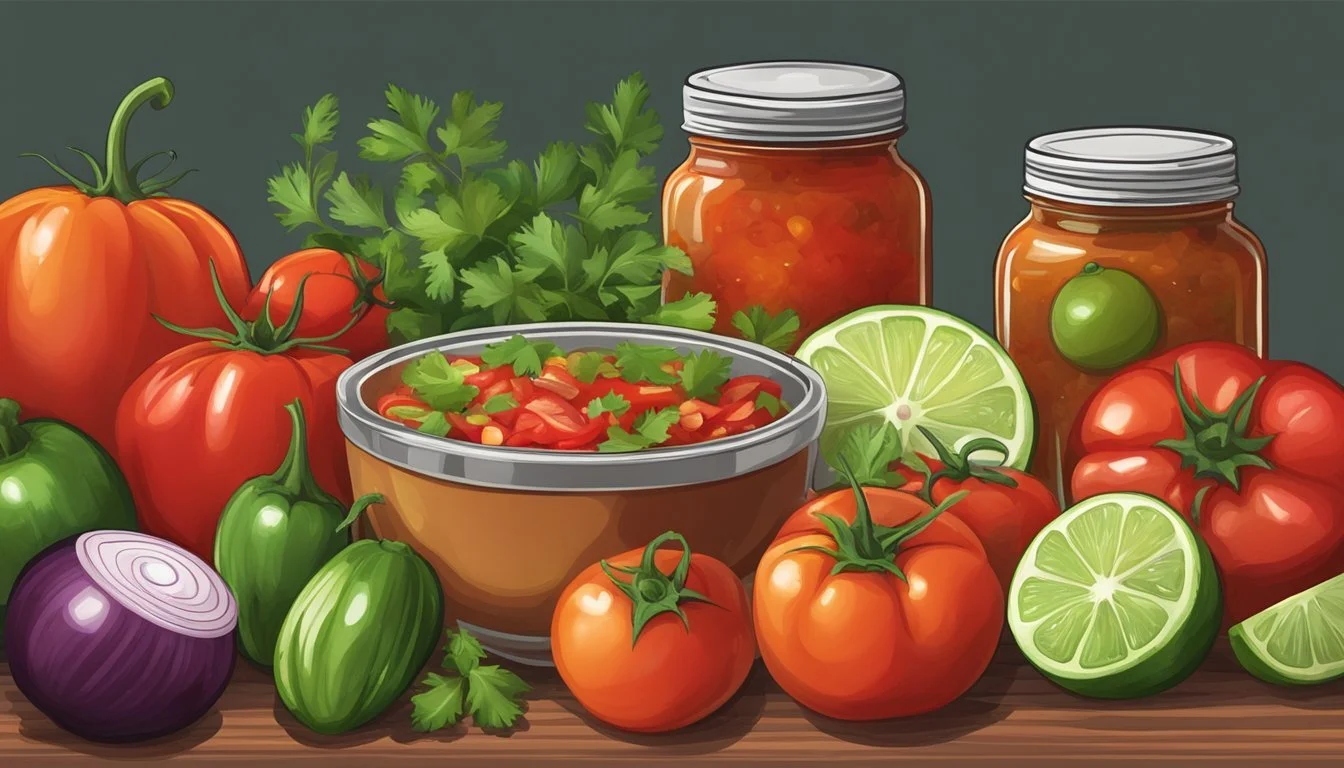Salsa Substitutes
Top Alternatives for Your Recipes
Salsa, the vibrant and often spicy condiment that graces many dishes, can be a cornerstone of flavor for various recipes. It brings together a mix of tomatoes, onions, peppers, and spices that can enhance the taste of tacos, burritos, and even eggs. However, there are times when salsa may not be available or when one's dietary preferences call for an alternative. Whether it's due to unavailability, a desire to experiment with new flavors, or the need to cater to specific dietary restrictions, cooks often seek substitutes that match salsa's distinctive character.
A myriad of substitutes exists that can mimic salsa's role in dishes, tweaking the flavor profile or texture to suit different palates or ingredients on hand. Ingredients such as chopped tomatoes provide a simple yet fresh alternative, capable of replicating the base of traditional salsa, while guacamole offers a creamy texture and the richness of avocado. Others might opt for salsa verde for a tangier taste, or pico de gallo for a chunkier consistency. Each substitute brings its unique twist to the table, ensuring that the absence of salsa does not leave meals tasting bland.
Understanding Salsa and Its Ingredients
Salsa, a vibrant condiment originating from Mexican cuisine, is celebrated for its fresh ingredients and robust flavors. This section will explore its core components, the critical role of tomatoes, the spices that add depth, and its nutritional benefits.
Fundamental Components of Salsa
Salsa's primary ingredients are:
Fresh tomatoes: Salsa's backbone, providing moisture and sweetness.
Cilantro: A herb delivering a distinctive citrusy flavor.
Lime Juice: Adds zesty acidity, balancing the flavors.
Chili Peppers: Introduce heat and complexity.
Role of Fresh Tomatoes
Fresh tomatoes are instrumental in salsa for their juicy texture and natural sweetness. They offer a bright acidity that underpins salsa's distinctive taste. Tomatoes also contribute phytonutrients and Vitamin C, enhancing the nutritional value of the dish.
Common Spices Used in Salsa
The spices in salsa typically include:
Cumin: Earthy taste.
Coriander: Mild, citrus-like flavor.
Oregano: Hint of bitterness and a slight sweetness.
These spices are selected to complement the freshness of the tomatoes and the sharpness of the lime juice.
Nutritional Profile
A standard serving size of salsa can provide:
Nutrient Benefit Vitamin C Antioxidant properties Capsaicin From chili peppers, may boost metabolism Fiber Aids in digestion
Salsa is a low-calorie option packed with various vitamins and nutrients from its fresh components.
Popular Salsa Variants and Substitutes
Exploring the world of salsa and its substitutes opens up a spectrum of flavors and textures suitable for various dishes. This section elucidates popular salsa types and their alternatives, focusing on homemade solutions, salsa verde, pico de gallo, and how picante sauce compares to traditional salsa.
Homemade Salsa Options
Creating homemade salsa allows for complete control over flavor and spice levels. A straightforward recipe involves chopped tomatoes, paired with onions, cilantro, and fresh peppers for a custom blend. Individuals can adjust ingredients to suit their preference, making a more personalized condiment.
Salsa Verde and Its Alternatives
Salsa verde, known for its tangy green tomatillo base, is a refreshing take on salsa. For an alternative, guacamole offers a creamy texture with similar ingredients like avocado and cilantro. Taco sauce, with a thinner consistency, can also provide a similar flavor profile in dishes requiring a green salsa.
Pico de Gallo as a Fresh Alternative
Pico de gallo is a chunky, fresh mixture of tomatoes, onions, cilantro, and jalapeños. Unlike traditional blended salsas, pico de gallo is not cooked, offering a crisp texture. Its freshness is ideal for topping tacos, burritos, or as a healthier dip option.
Comparing Picante Sauce and Salsa
While picante sauce and salsa can seem interchangeable, picante sauce typically has a more uniform texture and a spicier kick. For a milder taste, a ketchup-based sauce can be used as a substitute for salsa in some recipes, although it will not have the same complexity of flavor.
Non-Salsa Based Substitutes
When salsa is not available or one desires a change in flavor profile, there are several non-salsa based substitutes that stand out for their versatility and complementary taste. These alternatives can be cheese-based, derived from other sauces, or consist of creamy dips made from avocado or beans, and even condiments from various international cuisines.
Exploring Cheese-Based Dips
Cheese dip is a hearty alternative to salsa that can add richness to dishes. Options like queso fundido, a Mexican melted cheese dish with peppers, or a simple shredded cheddar cheese dip can complement nachos and tacos effectively. Sour cream or Mexican sour cream dip also offers a tangy flavor that pairs well with spicy foods.
Utilizing Different Sauces
Instead of salsa, one might consider various sauces such as enchilada sauce, which brings a similar zesty flavor to dishes. It can serve as a topping for Mexican food or as a base for casseroles. Other sauces like marinara or a bold barbecue sauce introduce new flavor dimensions to traditional salsa-centric dishes.
Avocado and Bean Dips
Avocado-based guacamole is a rich and creamy substitution for salsa, offering a different texture and taste. A simple blend of avocado, onion, and tomato creates a substitute that enhances nachos and burritos. Alternatively, bean dip, made from pureed beans, spices, and sometimes cheese, provides a protein-rich option.
International Condiment Alternatives
Looking globally, one can find numerous condiments that offer the robust flavors found in salsa. For instance, a Greek tzatziki sauce, which includes cucumber and garlic, or an Indian mint chutney, can be unexpected but delightful substitutes that introduce new cultural flavors to a meal.
By considering these non-salsa based substitutes, one opens up a world of flavor opportunities that can enrich and diversify their culinary experience.
Creative Salsa Replacements
When traditional salsa isn't an option, a variety of fruit-based alternatives, balsamic and sweet mixes, and even condensed soup blends can provide a surprising twist to dishes typically served with salsa. Each category offers distinct flavors and can be tailored to enhance a dish's taste profile.
Fruit-Based Alternatives
Utilizing fruits such as peaches and cherries can yield a delightful salsa substitute. These alternatives bring a natural sweetness that pairs well with savory dishes, offering a balance of flavor. For instance, a Peach Salsa can be made with diced fresh peaches, a hint of jalapeño for heat, and a splash of lime juice to maintain a salsa-like zing. Similarly, Cherry Salsa can include pitted and chopped cherries, mingled with fresh cilantro and a dash of red onion.
Peach Salsa
Peaches: Diced
Jalapeño: Minced
Lime Juice: To taste
Cherry Salsa
Cherries: Pitted and chopped
Cilantro: Chopped
Red Onion: Finely diced
Balsamic and Sweet Mixes
Balsamic vinegar can serve as a base for a salsa alternative that exhibits both sweetness and tang. By combining balsamic vinegar with fruits or a touch of honey, one can create a sauce that adds a sophisticated flair to appetizers. The addition of heat through chili flakes or a pinch of cayenne can balance the sweetness, making for a well-rounded dip or topping.
Balsamic Fruit Salsa
Balsamic Vinegar: 2 tablespoons
Honey: 1 tablespoon (optional)
Chili Flakes: To taste
Sweet and Heat Mix
Bell Peppers: Diced
Honey: For sweetness
Jalapeño: For heat
Using Condensed Soup Blends
Condensed soups, when thinned with a bit of water or broth, can act as intriguing stand-ins for salsa. While unconventional, they can be doctored with spices, herbs, and diced vegetables to mimic the chunky texture of salsa. For example, tomato soup can be transformed with fresh basil, a little onion, and some chopped bell pepper to create a salsa-like accompaniment for dishes needing a tomato-based component.
Condensed Soup Salsa
Tomato Soup: 1 can
Fresh Basil: Chopped
Onion and Bell Pepper: Diced
Health-Conscious and Dietary Substitutes
Seeking alternatives to traditional salsa not only accommodates various dietary preferences but also aligns with health-oriented goals. Here are selections that cater to a range of dietary needs without compromising on flavor.
Low-Sodium and Heart-Healthy Options
Options that are low in sodium are crucial for heart health. Fresh pico de gallo, made with chopped tomatoes, onions, and cilantro, offers a burst of flavor without the added salt. For a more dynamic taste, fresh fruit salsas using mango or pineapple provide a sweet yet tangy profile with ample phytonutrients and fiber, enhancing heart health while keeping sodium levels down.
Vegan and Plant-Based Selections
For those adhering to a vegan or plant-based diet, black bean salsa serves as a nutrient-dense substitute. Packed with protein and fiber, it supports satiety and digestive health. Another excellent vegan substitute is a tomato-based salsa with corn and bell peppers, offering a colorful mix of vitamins and minerals.
Keto and Paleo-Friendly Choices
Adherents of keto and paleo diets often seek high-fat and low-carb options. A keto cheese dip, combining shredded cheddar with almond milk and nutritional yeast, can mimic salsa's sharpness while staying within dietary constraints. Avocado-based guacamole also aligns with both keto and paleo diets, providing healthy fats and a creamy texture.
Gluten-Free and Low Allergen Alternatives
Gluten-free and allergen-friendly substitutes are a necessity for many. Guacamole inherently fits this category, being naturally free of gluten and most allergens. Additionally, vegetable salsas made with ingredients such as cucumbers, bell peppers, and radishes offer a crunchy, refreshing alternative that is naturally gluten-free and low in potential allergens.
Salsa Substitute Applications
When seeking alternatives to salsa, one can utilise an array of salsa substitutes across various dishes, ranging from simple snacks to more complex culinary creations. These alternatives not only mimic salsa's texture or flavor but also bring their own unique attributes to a dish.
Dips for Chips and Nachos
For the familiar crunch of tortilla chips or nachos, salsa substitutes like guacamole provide a creamy texture with a richness unparalleled by traditional salsa. This dip combines avocados, tomatoes, onions, cilantro, and lime juice, offering a balance of freshness and zest which pairs well with the simplicity of tortilla chips.
Substitute: Guacamole
Base Ingredients: Avocado, tomato, onion
Preparation: Mash avocado, dice tomato and onion, mix with salt and lime juice
Toppings for Tacos, Burgers, and More
Burgers and tacos can be transformed by substituting salsa with alternatives that maintain the spirit of Mexican flavors while offering diversity in taste and consistency. Pico de Gallo is a chunky and fresh option, while a creamy avocado sauce can add smoothness in lieu of salsa's acidity.
Substitute: Pico de Gallo
Base Ingredients: Tomato, onion, jalapeños, cilantro
Suggested Use: Fresh topping for tacos
Substitute: Avocado Sauce
Base Ingredients: Avocado, yogurt or sour cream, cilantro, lime juice
Suggested Use: Creamy spread for burgers
Culinary Uses Beyond Condiments
Salsa substitutes can extend beyond their role as condiments to become integral components of a dish. In cooking, one can use enchilada sauce or a spicy Rotel mix (diced tomatoes and green chilies) to bring a robust salsa-like flavor to casseroles or Mexican-inspired main courses.
Substitute: Enchilada Sauce
Base Ingredients: Tomato paste, chili powder, garlic, cumin
Culinary Application: Base for enchiladas or mixed into rice
Substitute: Rotel
Base Ingredients: Diced tomatoes, green chilies
Culinary Application: Mixed in soups, stews, or as a stand-in for salsa in recipes
Preparing Substitutes at Home
Creating salsa substitutes at home allows one to customize flavors to personal liking and ensure ingredients' freshness. Proper equipment and ingredient selection, along with seasoning precision and storage techniques, contribute significantly to the end product's quality and shelf-life.
Using a Food Processor or Blender
A food processor or blender is essential for achieving the desired consistency of salsa substitutes. Whether one prefers a chunky texture or a smooth puree, these appliances can provide control over the final outcome. For chunkier textures, a few pulses in the food processor will suffice; for smoother varieties, a longer blend time is necessary.
Food Processor: Ideal for coarsely chopping ingredients.
Blender: Best for smooth and creamy textures.
Selecting the Right Ingredients
Quality substitutes start with fresh ingredients. Fresh tomatoes, onions, and peppers form the backbone of many salsa-like dips. For a salsa substitute akin to guacamole, ripe avocados are crucial. When selecting ingredients, freshness and ripeness enhance the flavor of homemade substitutes.
Fresh Ingredients:
Tomatoes: Provide acidity and body.
Onions: Add sharpness and depth.
Peppers: Contribute heat and complexity.
Avocados: Offer creaminess when making guacamole-style substitutes.
Homemade Seasoning Mixes
Using homemade seasoning mixes instead of store-bought allows for customization and avoids preservatives. Seasonings typically include garlic, jalapeno, and various herbs. They should be balanced to complement the primary flavors rather than overpower them.
Seasonings to Consider:
Garlic: A staple for depth and aroma.
Cilantro: Lends a fresh, herbaceous note.
Lime Juice: Provides zesty brightness.
Salt: Enhances and melds flavors together.
Conserving and Storing Homemade Substitutes
To extend the life of homemade salsa substitutes, proper storage is necessary. Containers should be clean and airtight to keep out contaminants and preserve freshness. Refrigeration is key—the lower temperature slows down the degradation of flavors and colors.
Storage Tips:
Airtight Containers: Prevents oxidation and flavor loss.
Refrigeration: Maintains freshness for up to a week.
Commercial and Store-Bought Alternatives
In the space of commercial and store-bought salsa substitutes, consumers have various options ranging from standard tomato-based products to more inventive non-tomato alternatives. Availability and personal taste preferences determine the choice of substitute.
Understanding Jarred Salsa Varieties
Jarred salsa is a readily available substitute for fresh salsa, offering convenience and a shelf-stable option. It comes in a multitude of flavors and heat levels to match different palates. The ingredients typically mirror those of fresh salsa – tomatoes, onions, and peppers – but with preservatives to prolong shelf life. It's important for consumers to read labels to identify low-sodium options or those without added sugars, as these are healthier choices.
Navigating Tomato-Based Products
When fresh salsa isn't an option, tomato-based products such as tomato juice, tomato paste, and crushed tomatoes can serve as alternatives:
Tomato juice is a liquid substitute that can be reduced to intensify flavor.
Tomato paste offers a concentrated tomato flavor and needs dilution or additional seasonings for a salsa-like profile.
Spaghetti sauce and marinara sauce are seasoned tomato products that can mimic salsa in a pinch, especially if extra ingredients like chilies are added for heat.
Utilizing these substitutes requires creative seasoning to more closely align with the desired salsa taste.
Exploring Non-Tomato Options
Consumers not inclined to tomato-based salsa substitutes have a variety of options. Non-tomato alternatives include:
Avocado-based dips like guacamole, which provide a rich, creamy texture and can be customized with traditional salsa ingredients.
Fruit salsas made from store-bought chutneys or relishes can offer a sweet yet tangy profile, a departure from the classic tomato salsa but still a vibrant accompaniment to dishes.
These options allow for flavor variation and can cater to those looking for a different taste experience or those who might have tomato allergies.
Tips for Choosing the Right Substitute
When selecting a suitable salsa substitute, it is vital to focus on three primary aspects: the flavor alignment, consistency, and the specific culinary application.
Flavor Profile Matching
For a seamless flavor transition, the substitute should echo the distinctive taste of salsa. If the recipe calls for a classic tomato salsa, consider using pico de gallo or Rotel, which combines tomatoes with chilies. When a smoky depth is required, chipotle hot sauce or a blend featuring chili powder can be an appropriate choice. For dishes where a fruitier undertone is desired, a fruit-based salsa alternate, like ones with peaches or mangoes, may be suitable.
Matching the Dish's Consistency
Salsa's texture varies from smooth to chunky, which can affect the overall feel of the dish. When pasta sauce is used in lieu of salsa, it offers a similar consistency, working well in cooked recipes. For a thicker, creamier texture, guacamole serves as a reliable stand-in, especially for dips and spreads.
Substitute Salsa Type it Mimics Texture Pico de Gallo Fresh, Chunky Salsa Chunky Guacamole Thick, Creamy Salsa Creamy Pasta Sauce Cooked, Smooth Salsa Smooth to Chunky
Considering the Culinary Context
The context in which salsa is used should guide the selection of a substitute. Hot sauce may enhance a recipe where salsa's role is primarily to add heat. In contrast, rotel or other diced tomato products work best where the tomato flavor is critical. For casseroles or stuffed peppers, a salsa-like condiment or dish-specific sauce, such as enchilada sauce, could be more appropriate.
Dips: Guacamole or a bean dip can match the consistency and use of salsa.
Tacos: Pico de gallo, hot sauce, or a thin chili powder-based sauce can complement the other taco fillings.
Cooked Dishes: Consider pasta sauce, enchilada sauce, or salsa verde to maintain the moisture and flavor profile.











